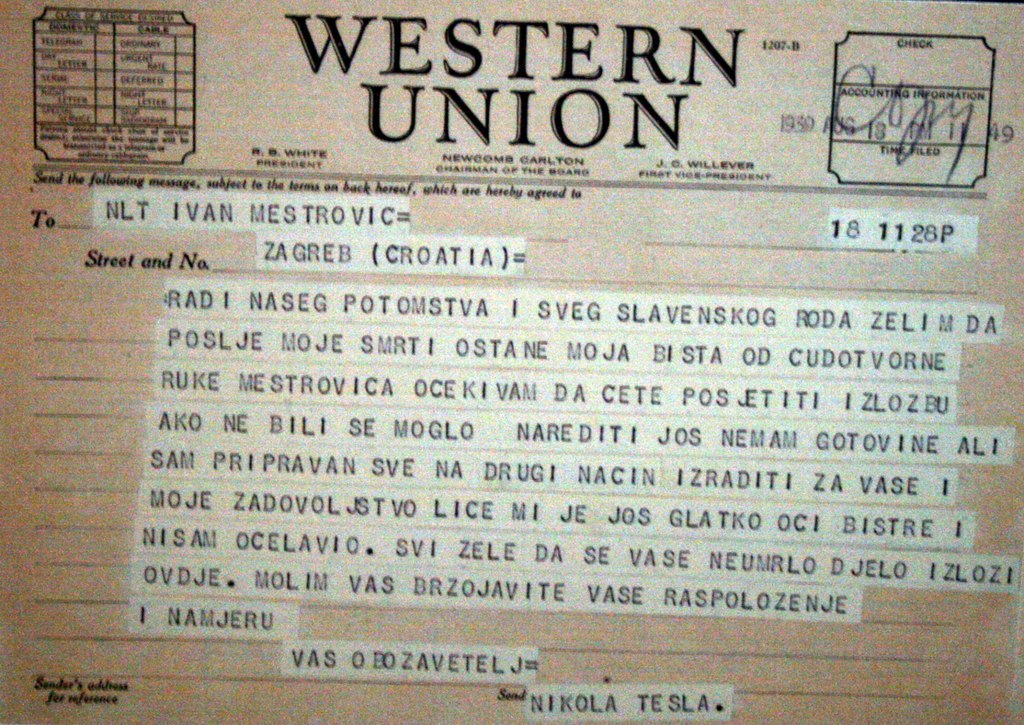Number of Persons With Health Insurance Exceeds Number of Residents by 209,000
January 16, 2022 - Although the latest census shows that all Croatian counties, including the City of Zagreb, have fewer residents than 10 years ago, the number of persons with health insurance in Croatia still exceeds the number of its residents by 209,000 and the number of voters exceeds the number of adults.
According to the first results of the 1021 census, Croatia has a maximum of 3,888,529 residents while on 3 January 2022 it had as many as 4,097,903 persons with health insurance, says the Večernji List daily of Sunday.
After the census, it will also be necessary to make order in the voter register, which contains the names of 3,690,623 persons of age, which is impossible given the country's existing number of residents and the fact that according to the national statistical office's estimates in 2020, there were more than 700,000 young people in Croatia.
Demographers had previously warned of the long-lasting problem of fictitious health plan beneficiaries, noting that those were most probably Croatian nationals - ethnic Serbs who had left Croatia, Croats from Bosnia and Herzegovina, Croatians who had emigrated without having cancelled their health insurance, as well as foreign nationals who own real estate on the coast.
There are no precise estimates as to how many of those beneficiaries who do not reside in Croatia use "free" health services and how many of them are emigrants and people only formally registered with the Croatian Health Insurance Institute but the problem should now be solved, notably following the introduction of population registers that exist in most EU countries. The EU has recommended that member countries compile population registers by the end of this year.
Even though the first results of the 2021 census do not leave any reason for optimism, it is worthwhile noting that in addition to the only county seat, Čakovec, there are still smaller cities, as well as large and small municipalities, whose population size has increased over the past ten years. Those are, among others, Solin, Sveta Nedelja, Dugo Selo, Krk and Biograd na Moru.
Of the municipalities whose population has increased, those are primarily large municipalities - Viškovo near Rijeka, Podstrana near Split, and Župa Dubrovačka and Konavle in the south of Dalmatia.
As for municipalities with fewer than 5,000 inhabitants, compared to 2011 the number of residents has increased also in Poličnik, Sukošan, Pakoštane and Galovac, municipalities in the area of Zadar, Dugopolje and Bol on the island of Brač, municipalities close to Split, Omišalj and Malinska - Dubašnica on the island of Krk, Bilice near Šibenik, Tar - Vabriga in Istria County, and Orehovica in Međimurje County.
Another positive example is Vis, the island farthest from the mainland that over the past ten years has lost only seven inhabitants, owing to its consistent and comprehensive demographic policy. The remote municipality of Baška on the island of Krk, which has a proactive demographic policy, has lost only one resident in the past ten years, Večernji List says.
According to the Jutarnji List daily of Sunday, the results of the 2021 census will also have an effect on the number of councillors in local bodies of representation.
In the next local elections, in 2025 and 2029, voters will elect 352 fewer councillors in local bodies of representation, as a result of the fact that the latest census shows that Croatia's population has shrunk by almost 10% compared to 2011.
Under the Act on Local and Regional Government Units, the number of councillors in local representative bodies is determined on the basis of the number of residents in individual counties, cities and municipalities.
5,732 New COVID-19 Cases, 45 Fatalities in Croatia
January 16, 2022 - In the last 24 hours, 5,732 COVID-19 cases have been confirmed and 45 deaths have been registered in Croatia, the national COVID-19 crisis management team said on Sunday.
There are 55,499 active cases, including 1,717 hospitalised patients, of whom 224 are on ventilators, while 25,448 persons are self-isolating.
Croatia has registered 817,435 coronavirus cases to date. The death toll is 13,118.
To date, 56.19% of the population has been vaccinated, including 66.90% of adults, of whom 64.23% fully.
Gracija Filipović Among Europe’s 10 Biggest Acting Hopefuls
January 16, 2022 - Croatian actress Gracija Filipović, who made her leading role debut in Antoneta Alamat Kusijanović's feature film Murina, has been included in the European Shooting Stars programme of this year's Berlin International Film Festival.
"We are impressed by her intuitive and original acting, which she performs with a level of maturity surprising for her age," the jury said in their decision to include the Croatian actress in the European Shooting Stars programme, according to the Croatian Audiovisual Centre (HAVC).
Every year the European Shooting Stars programme presents the best new European acting talents during the Berlinale.
Thanks to the numerous awards to Murina, the most notable being the Golden Camera in Cannes, Gracija’s collaboration with Antoneta brought her international visibility and recognition, which ultimately contributed to her inclusion in this prestigious Berlinale programme, HAVC said.
Apart from acting, Gracija Filipović is also a professional swimmer and step dancer. She is studying biology in Zagreb.
Filipović is the fourth Croatian actress to be admitted to the European Shooting Stars programme after Zrinka Cvitešić (2010), Marija Škaričić (2011) and Tihana Lazović (2016).
The 25th edition of the European Shooting Stars programme, featuring seven actresses and three actors, will be held in hybrid form during the first weekend of the 72nd Berlinale, from 11 to 14 February. The award ceremony will take place on the last day when awards will be presented to all programme participants.
‘Your Fan, Nikola Tesla’: When the Great Inventor Met Ivan Meštrović
January 16th 2022 - Ivan Meštrović, a master sculptor and one of the most renowned Croatian artists of all time, died on this day in 1962. A lesser known fact about Meštrović is that he was friends with another famous figure from these parts, the great inventor Nikola Tesla. The two great men met in New York and maintained a decades-long friendship through correspondence
Ivan Meštrović, a master sculptor and one of the most renowned Croatian artists of all time, died on this day in 1962. Having gained United States citizenship a few years earlier, Meštrović passed away in the US, after an illustrious international career and numerous accolades won for his exceptional artistic work.
He was one of the rare Croatian artists to gain international recognition during his lifetime: he lived, worked, taught, and exhibited his art in Split, Paris, Rome, Belgrade, Zagreb, London, Geneva, Cannes, and all over the US. He was the first living artist to get a solo exhibition at the Metropolitan Museum in New York (1947).
Meštrović was the genius mind behind some of the most recognisable landmarks and monuments in Croatia. The Well of Life was installed in front of the Croatian National Theatre in Zagreb in 1912:
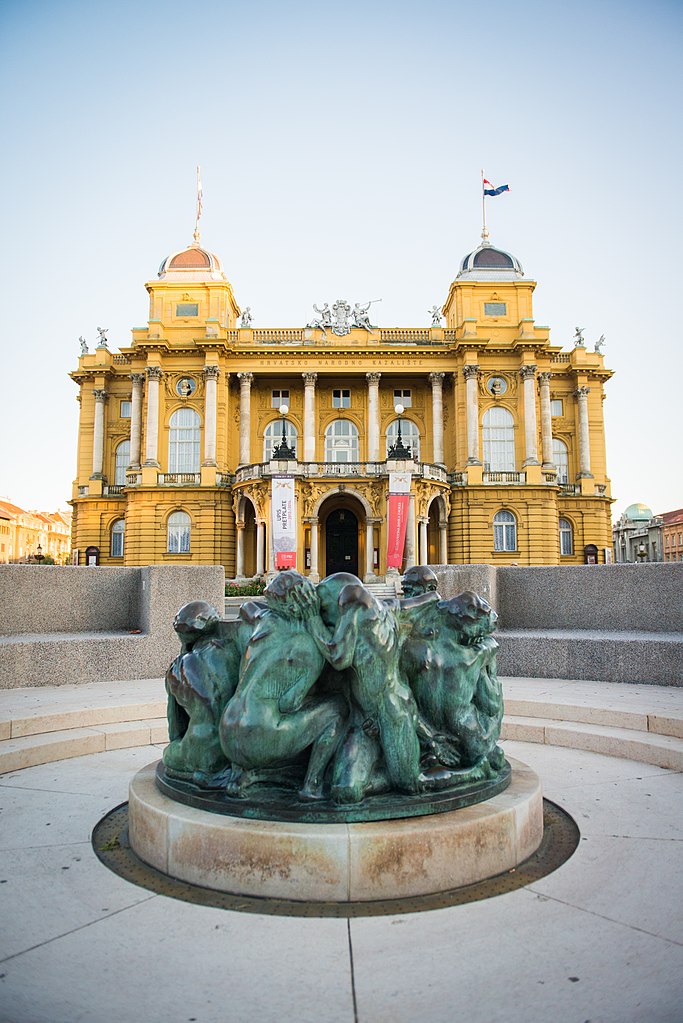
Another iconic landmark in Zagreb, the Home of Croatian Artists also known as Džamija (The Mosque), was designed by Meštrović and completed in 1938 - hence its other nickname, the Meštrović pavilion:
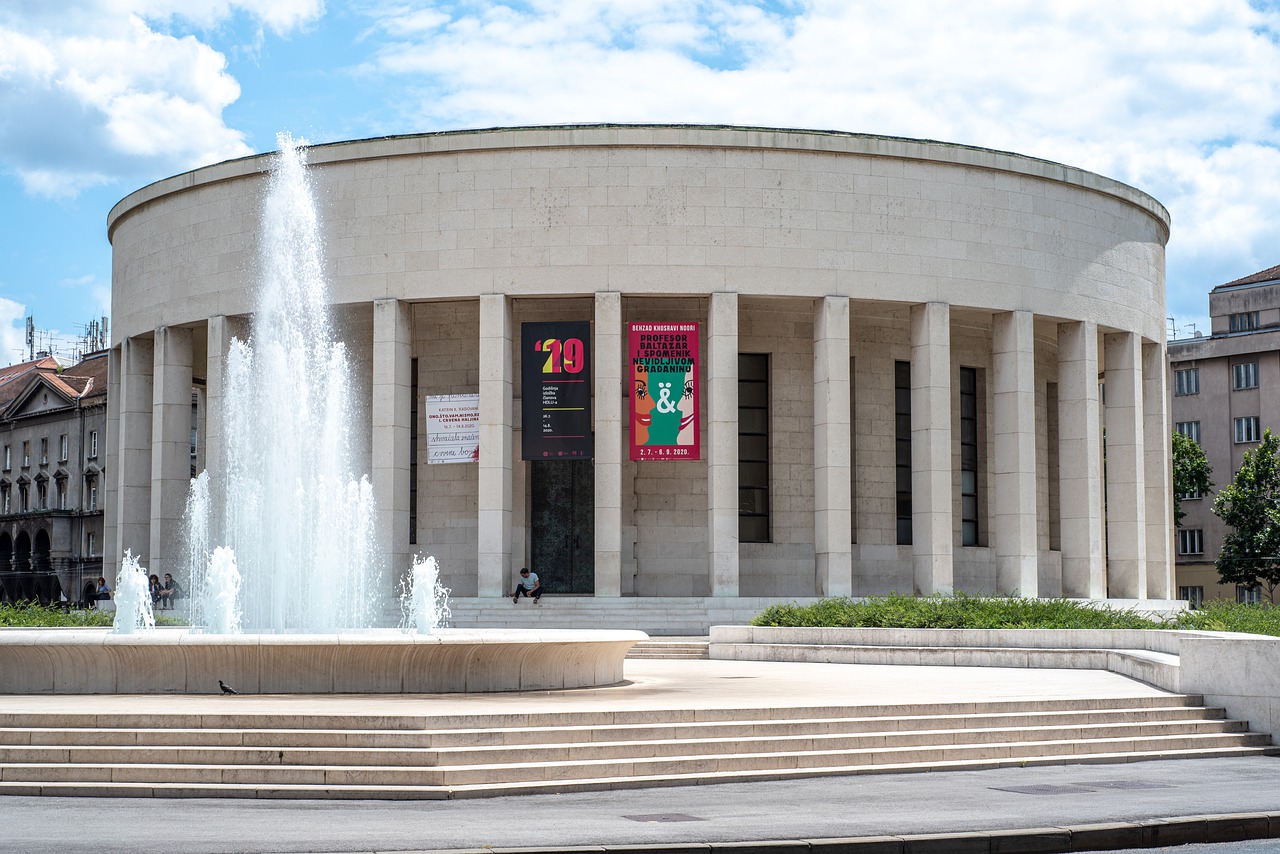
The gigantic statue of Gregory of Nin (Grgur Ninski) was initially installed at the Peristil in Split and later moved to its present location in front of the Golden Gate, where tourists in passing rub the saint’s big toe for luck.
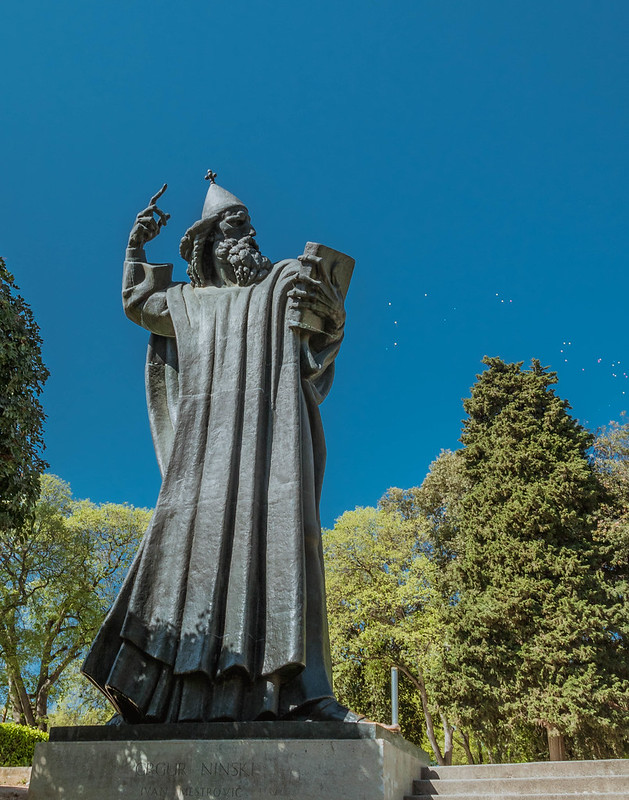
Photo: Statue of Gregorius of Nin in Split, Croatia by Marco Verch under Creative Commons 2.0
A lesser known fact about the master artist is that he was friends with another famous figure from these parts - the great inventor and scientist Nikola Tesla.
Tesla and Meštrović met in New York in 1924, where Meštrović had a solo exhibition at the Brooklyn Museum. Knowing that Tesla was also residing in New York at the time, the artist reached out with a letter expressing his wish to meet, sent from Hotel Gotham on December 13th:
Dear Mr Tesla, one of my main wishes in coming here was to meet you, wrote Meštrović.
Tesla wrote back from Hotel Marguery two days later:
Dear and great artist! I was happy to receive your letter and will be even more glad to meet you in person, as this has been a fervent wish of mine for many years now, replied Tesla with enthusiasm and proposed a meetup time. This was the beginning of a long friendship between the two men, each a master in his own field.
***
In the years that followed, Tesla saw other exhibitions of Meštrović’s work in the US, and wrote to the artist to express his admiration after an exhibition in Chicago in 1929.
They exchanged Christmas cards as well; they are kept at the Nikola Tesla Museum in Belgrade together with the letters and telegrams.
Another touching letter dates to November 12th, 1929 when Meštrović acted as a middleman for Matica srpska, a distinguished Serbian cultural-scientific institution that wanted to publish a biography of the great inventor.
I don’t know why they chose to go through me: either you weren’t replying to them, or they think you and I are closely acquainted making this a more convenient way [to reach you]. I would ask you to accommodate their request, not for their sake or mine, but for the sake of our nation, and most of all for the sake of younger generations who will see in you the most wonderful example of intellectual and moral virtue, urged Meštrović, going on to suggest that Tesla set a condition for his autobiography to be published in both the Latin and Cyrillic script.
***
In a telegram sent in 1939 Nikola Tesla expressed his wish for Meštrović to sculpt a bust of him.
Artists were known to frequently approach Tesla to ask if he would sit for a portrait, and he turned them all down - save for princess Vilma Lwoff-Parlaghy whose drawing was unfortunately lost. That he would personally reach out to Meštrović to commission a portrait bust only speaks to his respect for the master artist.
This is the telegram:
Sent from NYC to Zagreb on August 18th, 1939
The message reads,
For the sake of our descendants and all Slavic people I wish for a bust of me, made by the miraculous hand of Meštrović, to remain after my death. I don’t yet have cash, but I am willing to do everything to your satisfaction and mine by other means. My face is still smooth, my eyes bright, and I haven’t gone bald. Everyone wishes for your immortal work to be displayed here. Please send a telegram to state your opinion and intent. Your fan, Nikola Tesla.
Imagine having Nikola Tesla for a fan.
Meštrović promptly wrote back from Split:
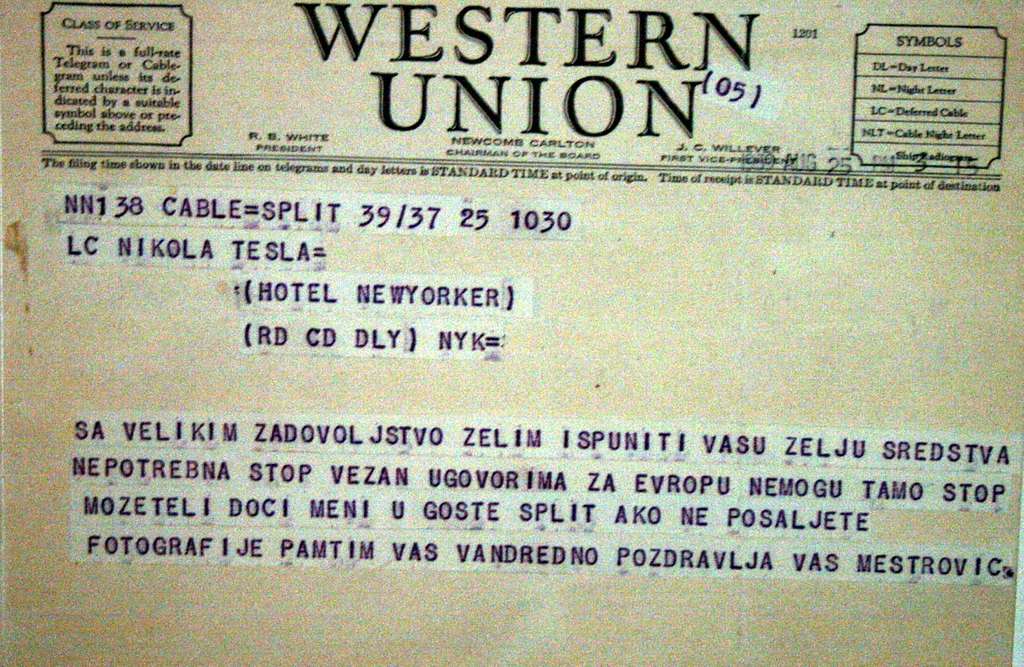
Sent from Split to NYC on August 25th, 1939
The telegram sent to Tesla reads,
It would be my great pleasure to fulfil your wish. Funds not necessary. I am bound by contracts in Europe, I can’t go there [USA]. Can you be my guest in Split, if you can’t, send some photos, I remember you vividly. Greetings from Meštrović.
Tesla was 83 years old at the time and was unable to travel that far, so he didn’t get a chance to pose for Meštrović before he died. The master sculptor kept his word regardless, creating two sculptures of Nikola Tesla in the years that followed.
One is a bronze bust whose original plaster model is displayed at the Croatian Academy of Sciences and Arts in Zagreb; bronze replicas are on display at the Nikola Tesla Museum in Belgrade and the Technical Museum in Vienna.
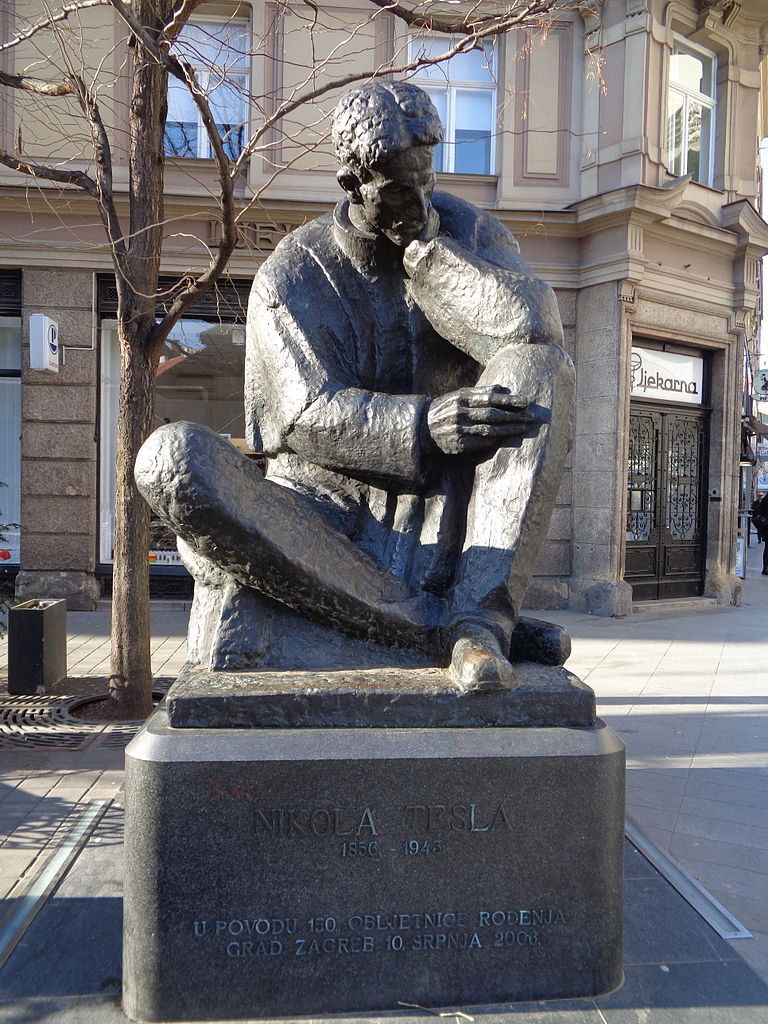
The other is the grand monument of Tesla displayed in Zagreb, shown on the photo above. It was originally installed in front of the Ruđer Bošković Institute in 1956, after Meštrović personally reached out to Croatian physicist Ivan Supek, the founder of the RB Institute. Supek recalled his correspondence with the artist for Jutarnji list/Tanja Rudež.
Meštrović was teaching at the University of Notre Dame in the US at the time, but kept close ties with his homeland. After an earlier sculpture of his, that of Croatian scientist Ruđer Bošković was installed in front of the Institute, he wrote to Supek saying he considered Tesla one of the greatest men from these parts. He said that he would gladly build Tesla a monument and asked for Supek’s opinion - naturally, he agreed, and the work was thus completed and displayed at the institute a year later.
In 2006, the monument was moved to its present location in the city centre, in the street named after Nikola Tesla.
To learn more about Ivan Meštrović and his legacy, visit the pages of Ivan Meštrović Museums / Muzeji Ivana Meštrovića.
Bagatin Global Anti-Aging Treatment: For Flawless Skin Even During Split Bura
January 16, 2022 - How the Bagatin global anti-aging treatment brought life back to my bura-broken skin in Split.
There are several reasons why Bagatin Polyclinic is the best.
And it's not just because they were named the International Cosmetic Surgery Clinic of the Year at the prestigious IMTJ. Or that they became the first clinic in Croatia and only the 65th in the world to receive the coveted TEMOS Accreditation - in the fields of Medical Tourism Excellence and Quality of International Patient Care. Or that 11 Bagatin Clinics’ doctors made the list of best doctors in 2018 chosen by patients from all over Croatia (najdoktor.com).
Or even because Bagatin Clinic was named the leading dermatology clinic in Europe according to the analysis of European dermatology clinics, as compiled by Global Clinic Rating – an international accreditation body for medical institutions.
The Bagatin success story is evident in many ways, but perhaps best shown in how it grew from a small Bagatin brothers' operation with a turnover of only 30,000 euro offering just aesthetic surgery in 2008, to over 100 employees in 2018 and revenues of 5.5 million euro with four departments (and 120 employees in 2019).
And once you finally visit the Bagatin Polyclinic, all of these accolades make a lot more sense.
While I have written about Bagatin's honors over the years, I first visited the Split clinic late last year after a skin flare-up prompted me to take a deeper look into what was going on under the surface - and the VISIA Skin Analysis was just what I needed.
Whether I left the appointment happy or not, I can't say, but that had nothing to do with the standout experience itself. However, learning that only 1% of my skin was not inflamed, my rosacea is off the charts, and the 2+ liters of water I drink a day is doing nothing for my dehydration was precisely the wake-up call needed to kick my skin into shape. From that point on, I was dedicated to investing in my skin health and was grateful for the treatment map medical cosmetologist Daniela Šestan personalized for me.
Now that the holidays (and excessive eating and drinking) are over, I took the first step to new skin with the Reviderm global anti-aging treatment earlier this week. And it could not have come at a better time.
I, fortunately, made an appointment at Bagatin on the final day of bura in Split last week.
My skin - parched. My lips - cracked. My broken capillaries - fresh.
I needed rehydration - and fast.
I had no idea what to expect other than that I needed to spare an hour and a half for the treatment. Professional as can be, Daniela promptly greeted me in the Bagatin waiting room right on schedule to begin.
"You don't need to do anything other than relax," she said, which are words I rarely hear, so I made sure to make the most of it.
The treatment began with Daniela cleansing and cleaning my face with massage-like strokes that almost had me asleep within the first 5 minutes of the treatment! After a thorough cleaning, Daniela used an ultra-light enzyme scrub so as not to damage my skin any more than the wind already had. After a gentle exfoliation, it was time for mild microdermabrasion, which Daniela ensured would not hurt, nor would it be too harsh for my skin type. You could really feel the crystals working off the dead skin cells, which in turn improves the appearance of sun damage, wrinkles, fine lines, age spots, and acne scarring.
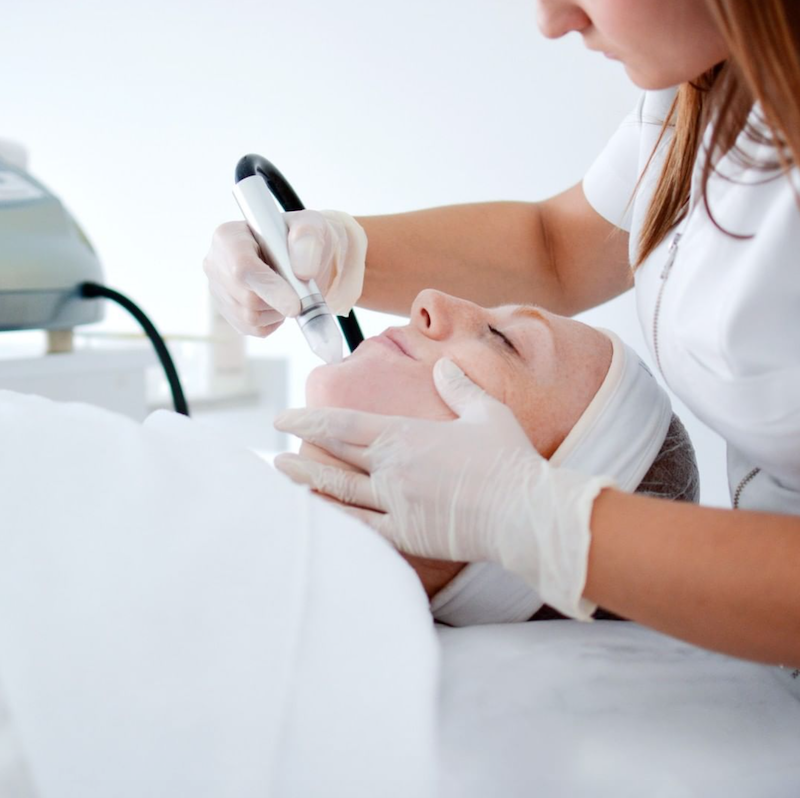
After every section of my skin was thoroughly treated, Daniela used a series of serums, which were penetrated deeper into my skin thanks to ultrasound therapy, which helps the skin create new collagen while improving its firmness and elasticity. The painless ultrasound therapy was done in two 12-minute parts on each side of my face. The warmth from the treatment even helped me nod off a few times! Daniela said my forehead lines reacted very well to the ultrasound, which I could still notice four days later.
The most unique part of the treatment is the final act - the collagen wrap. After more serums were smoothed on my skin, Daniela wrapped my face with pure collagen, covering my eyes and mouth with only open space over my nostrils to breathe. While this may sound scary, the collagen wrap is activated with a cooling liquid and is kept on for 20 minutes - or 'nap time' as Daniela called it. And I promise you won't remember another time you napped so well.
Daniela finished the treatment with moisturizer and the most important ingredient them all - SPF. An hour and a half later, my skin journey had taken its successful first step. When I looked in the mirror, I noticed a glow I hadn't seen in years, fewer fine lines, and an immense reduction in the redness I've just accepted as the norm. But it doesn't have to be.
As with any treatment plan, dedication is key, and the Bagatin neuroscience treatments are up next in my healing process.
Your skin doesn't have to suffer in Split so long as you have Bagatin around.
You can find all of Bagatin's services on their website.
To read more about lifestyle in Croatia, follow TCN's dedicated page.
TUI Zadar Flights Added to Croatian Destinations, Austria Airlines Zagreb Flights Temporarily Suspended
January 16, 2022 - The latest flight news to Croatia as TUI Zadar flights are on the list of Croatian destinations this summer, while Austria Airlines will temporarily suspend Vienna-Zagreb flights from Monday.
TUI fly Belgium, a member of the well-known TUI group specializing in organized tourist trips to a number of well-known leisure destinations, including Croatia, has announced a number of destinations in the upcoming 2022 summer flight schedule.
In the past summer season, TUI Group planes flew to Pula, Dubrovnik, and Split, and this year, according to the announcements, we can expect them in Zadar as well, reports Croatian Aviation.
Just like last year, TUI has strengthened its network of destinations this year by adding four new airports to its list.
The list of airports for 2022 according to which TUI fly Belgium plans to operate along Zadar includes Havana (Cuba), Aruba (Netherlands Antilles), and Ohrid (Northern Macedonia).
According to currently available data, flights from Brussels (BRU) to Zadar have been announced from April 23 to October 1, and TUI fly Belgium aircraft on this route should operate twice a week, on Wednesdays and Saturdays.
Croatian Aviation adds that although the summer season and the whole of 2021 were very challenging for the airline industry, it seems that this airline believes that the 2022 summer season should be more successful, so in the announcement for the upcoming season, all destinations from 2021 remain on the list of destinations, including four new ones.
In 2022, TUI fly Belgium plans to offer 95 destinations and 168 routes, and flights should take place from airports such as Brussels, Ostend, Antwerp, Charleroi, Liège (Belgium), and Lille (France).
Furthermore, Ex Yu Aviation reports that Austrian Airlines will temporarily halt Vienna-Zagreb flights from Monday, for the third time in the last two years. The service should be suspended until at least February 28.
"Due to the rapidly evolving pandemic situation, during the second half of January and part of February, certain flights have been cancelled, but the majority are on sale from February onwards. Zagreb Airport is in contact with airlines across the world. However, due to the confidential nature of such contacts, we cannot share any more information at this time," Zagreb Airport said.
Croatia Airlines will continue to fly between Vienna and Zagreb with three weekly flights planned.
For more on flights to Croatia and other travel announcements, make sure to check out our dedicated travel section.
From Sting to The Cure in Zagreb: TCN Meets Concert Promoter Nick Hobbs of Charm Music
January 16, 2022 - TCN spoke to Nick Hobbs of Charm Music Croatia, a concert division of the Charmenko group in Eastern Europe organizing the biggest shows in the country this year - from Sting to Arctic Monkeys and The Cure.
If there is one thing Croatians can be excited about this year, it is a stacked concert calendar, which is more than welcome after two years of cancellations due to the COVID-19 pandemic. In addition to the return of music festivals on the coast, Croatians are particularly looking forward to three massive shows this year announced at the end of 2021 - Sting at Arena Zagreb, Arctic Monkeys at Pula Arena, and The Cure at Arena Zagreb.
TCN spoke to the man responsible for making these gigs happen - Nick Hobbs of Charm Music, a concert division operating under the Charmenko group of companies specialized in international music organization.
How did you get into promoting concerts?
It's a long story. When I was 23, I organized an Italian tour for Henry Cow, and I promoted one of the shows myself. They asked me to be their manager.
I moved to London, and a year later, the band split. I carried on working with them on offshoot projects, then I moved to Stockholm for a year and worked for a promoter as their international buyer. Then I moved back to London and joined Rough Trade in about 1985 as an artist agent for their roster outside the UK. I then started managing David Thomas and Pere Ubu and some other acts and gradually, over the years, developed an interest and contacts in Eastern Europe. By about 1995, EE was my main work, so it has been since. In 2003 I moved to Istanbul.
Tell us about Charmenko and Charm in general. What are some of the biggest acts on your roster?
I can’t remember when I came up with the name, but it was maybe around 1990. It was just me plus a small crew of London-based staff for a long time, and we worked from my home in Brixton. Now we have our own offices in Turkey, Serbia, Croatia, Czechia, and Poland and clients all over EE. We also have our own roster of artists that we represent more or less worldwide.
I’ve worked with many big acts over the years, but off the top of my head...
Radiohead
Muse
George Michael
U2
Ed Sheeran
Rihanna
Beyoncé
Elton John
David Bowie
Lou Reed
Nick Cave
Oasis
Blur
Rammstein
and many others.
Really exciting concerts were announced in Croatia this year, from Sting to Arctic Monkeys and The Cure. How are the interest and ticket sales so far? Do you expect sellouts?
We expect Sting to sell out, Arctic Monkeys are already sold out, and we hope The Cure will sell out; they’re a great live band!

Croatia is not always viewed as a desirable destination for touring musicians, as many acts choose other cities in the region. Why do you think that is?
It's a small country…and the further south you go into the Balkans, the more straggly concert possibilities become. Anyway, the Balkans are much more developed than they were 20 years ago. So the trend is positive - as long as Bosnia doesn’t fall apart - we hope not!
What difficulties have you encountered when promoting and organizing shows in Croatia?
Mostly no special difficulties and generally we’ve not had disasters in Croatia and, with one minor exception, the clients we’ve worked with have always paid us - that’s nice. One particular difficulty is that Serbia and Bosnia aren’t part of the EU. Once they become part of the EU, all kinds of opportunities will open for Croatia too. Borders are stupid, just like nationalism is.
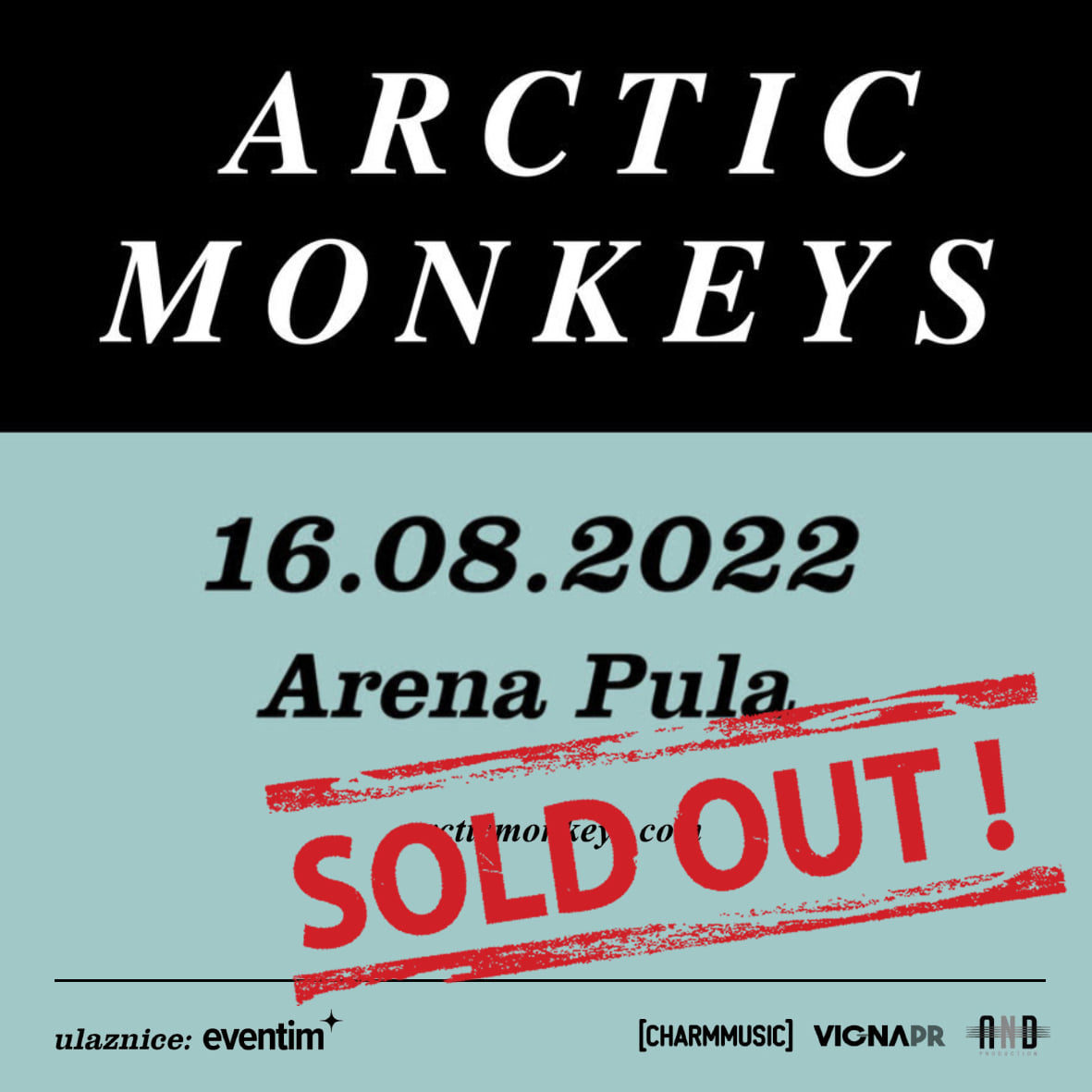
Charm has announced concerts in Zagreb and Pula - anything planned for Split or the Dalmatia region? If not, why?
Zagreb is the capital. Pula has the arena. I’ve done shows in Split; not easy to make them work financially. Usually, provincial shows with international artists rather depend on municipal support for them to be viable. Split is also further from Slovenia, which is an overlapping market with Zagreb and Pula.
What would make promoting and organizing concerts in Croatia easier for Charm Music?
I hope we will develop our own office further. In the end, the concert business depends on ticket buyers. My own wish is for us to be able to work with more left-field artists, but we worked with Terra Neo, for example; it wasn’t a commercial success. Better connections with venues and municipalities would be good, too.
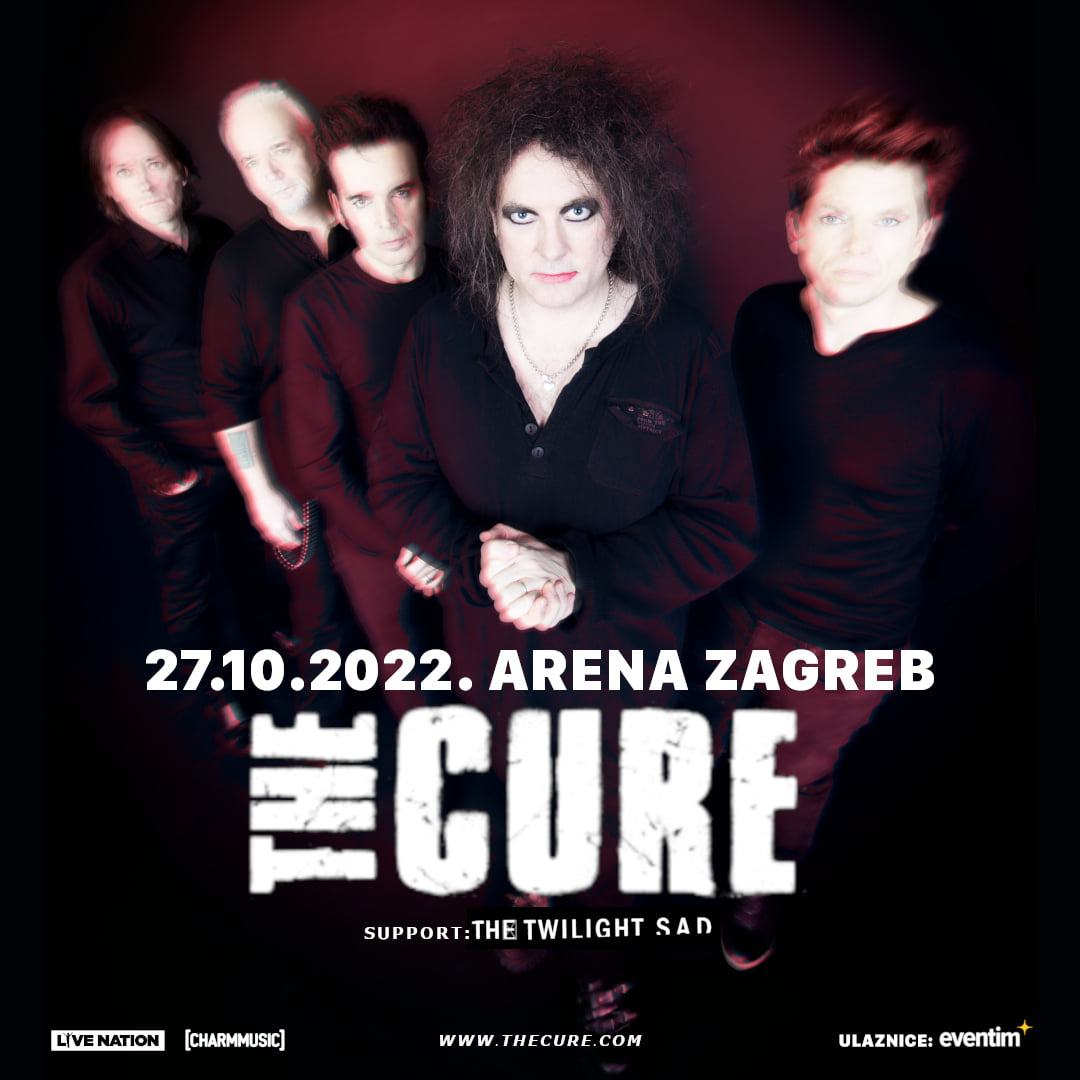
What else can we expect from Charm in 2022?
There's a lot of great music around that we'd love to promote but selling enough tickets to cover the costs is very, very tricky and very, very risky. So we have lots of discussions internally, and we have lots of ideas.
Learn more about Charmenko and Charm Music Croatia.
For more, check out our dedicated lifestyle section.
Get to Know Your Country: Free Tour of Sinj Organized
January 16, 2022 - A free tour of Sinj was organized on Saturday, January 15, as part of the 'Get to Know Your Country' project by the Croatian Tourist Guides Association.
On Saturday, January 15, as part of the 'Get to Know Your Country' project organized by the Croatian Tourist Guides Association, and on the International Recognition Day of the Republic of Croatia, the Sinj Tourist Board organized a free tour of Sinj, in cooperation with the Sinj Tourist Guides Association "Osinium," the Sinjska Alka Museum, the Cetina Region Museum, and the Sikirica Gallery.
On this occasion, many interested citizens of Sinj and the Cetina region, as well as visitors from Kaštela, Klis, Knin, Split, and Solin, visited the Cetina Region Museum where they explored the permanent exhibition "Statue of the Bible - the body of language from all continents" by Siniša Vuković, Sikirica Gallery and the exhibition of photographs "Angels" by Ivo Pervan, and the famous Sinjska Alka Museum, all with the expert guidance of Ivan Vuleta, tourist guide and Danijela Banović Petričević, curator of the Cetina Region Museum.
They helped participants learn more about the knightly city of Sinj, prominent people who influenced its development, numerous public sculptures, the Franciscan Classical Gymnasium - the first gymnasium in southern Croatia with Croatian as the language of instruction, Grad Fortress, the Church of Our Lady of Sinj - the largest southern Croatian Marian shrine, which includes the Image of the Miraculous Lady of Sinj, the votive church at the Grad Fortress, the miraculous defense of the city of Sinj in 1715 and the significance of the Sinj Alka, a knight's game under UNESCO protection.
All participants received a 2022 calendar to remember the day from local and world-famous designer Boris Ljubičić.
For more on Inland Dalmatia, follow TCN's dedicated page.
Croatian Exports to Slovenia Blow Up, 2019 Record Exceeded by 25%
January the 16th, 2022 - Croatian exports have done well despite the circumstances posed by the ongoing coronavirus pandemic, and exports to neighbouring Slovenia have exceeded pre-pandemic 2019's record by an impressive 25%.
As Poslovni Dnevnik/Marija Brnic writes, statistically speaking, ''last year'' isn't quite over yet, but it is already clear that 2021 was a record year in economic relations with Croatia's most important foreign trade partners, in which Italy returned to first place on the list of the main Croatian export markets.
Last year will also be recorded as a time when perhaps the strongest shift was achieved in relations with neighbouring Slovenia, especially when it comes to Croatian exports.
Economic relations between the two neighbouring nations are traditionally good, but in the first ten months of 2021, the Central Bureau of Statistics recorded that trade increased sharply and in absolute terms greatly exceeded the level of the pre-pandemic year of 2019, and if the trend did continue in November and December 2021 (which is yet to be confirmed), it is likely that the total exchange will exceed the results of the record year of 2019. In the case of Croatian exports, this has already happened.
From January to October 2021, as much as 1.808 billion euros worth of goods from Croatia were exported to Slovenia, 171 million euros more than during the whole of 2019, which was a record, and if you look at the same period in that year, the result is better by as much as 452 million euros.
Speaking in percentages, back in 2020, in the conditions of the then very slow and unstable economic life, Croatian exports to Slovenia stopped their growth for the first time in more than a decade and had a deficit on an annual basis (of about 6%), but last year, in that 10 month period, it grew by 42% on an annual basis), largely making up for lost time, so compared to the same period, Croatian exports to Slovenia were higher by 25%.
This result gains even more strength and weight if compare it with Croatian exports to Germany, the second market for domestic products, which in those first 10 months of 2021 amounted to only slightly more. The reason for the convergence of sales values to these two markets should not be sought in the negative trend with Germany, since Croatian exports had a better performance here as well.
What was the generator of accelerated growth of foreign trade between Croatia and Slovenia, you may ask? The Croatian Chamber of Commerce assesses that the step forward in trade relations at the general level, and thus in relations with Slovenia, was greatly contributed to by the increasingly pronounced trend of rising global prices.
"According to the analysis of the structure of Croatian exports to Slovenia, the causes of this growth can be mostly attributed to the increased value of the exports of petroleum oils and oils derived from bituminous minerals and electricity, which is due to a significant increase in energy prices on the global market last year."
The CBS states that electricity worth 45.7 million euros was exported to Slovenia in 2019, as were petroleum oils and oils obtained from bituminous minerals, worth 15.5 million euros. In the first nine months of 2021, electricity was exported in the amount of 183.3 million euros, and petroleum oils and oils obtained from bituminous minerals were exported in the amount of 67 million euros.
A different structure of exports
At the same time, there was a smaller increase in Croatian exports of aluminum products, various plates, sheets and strips, despite the strong rise in metal prices. They illustrate this with the fact that in the observed period of 2021, these goods were exported worth 118 million euros, while in the conditions of much lower prices back in 2019, the result is only slightly weaker, 110 million euros.
The value of Croatian exports of parts and accessories for motor vehicles, as well as glass products, they say, is declining. It's worth mentioning that in the structure of products in 2021, according to available data, electricity had the largest share (11.8%), and compared to the data on the structure from the previous year, in which it was not among the main export products, it exceeded the traditional main export products - aluminum plates and sheets (7.6%), and parts and accessories for motor vehicles (4.8%), and medicines and chocolates, which last year were not even among the top five products for the Slovenian market.
The automotive industry was going through a turbulent period last year, so Croatian manufacturers, the largest of which is AD Plastik, which cooperates with Revoz, slowed down its sales.
New jobs are now growing, especially in the services segment. Sasa Muminovic, President of the SLO-CRO Business Club, and a member of the Management Board of AquafilSLO and President of the Management Board of AquafilCRO in Oroslavje, a member company of the Italian group Aquafil, says the same. A survey conducted by this association among Slovenian and Croatian businessmen at the end of 2021 reveals a number of interesting things about how they see each other.
The characteristics of their neighbourly relationship
What characterises these relations is that Croatia is Slovenia's first country when they decide to enter foreign markets, and not, for example, Italy or Austria. Moore than half of the respondents estimated that they don't really see a difference in the business climate between these two countries, and as many as 62% of Slovenian businessmen believe that there are no obstacles to doing business in Croatia, while 26% find those obstacles in the country's infamous administration.
The answers are similar on the Croatian side, but both sides, which Muminovic points out are important, believe that economic relations are not disturbed by politics (only 6.7% of Slovenian and 2.6% of Croatian businessmen think differently).
For more, check out our dedicated business section.
Croatian Lawyer Fined 10,000 Kuna for Refusing to Disinfect Hands
January the 16th, 2022 - A Croatian lawyer has been ordered to pay 10,000 kuna for refusing to disinfect his hands as the coronavirus pandemic continues and hand washing is part of the most basic of epidemiological measures. He also referred to the disinfectant on offer to him as ''poison''.
As Poslovni Dnevnik writes, before the start of a main hearing in court recently, the judge told those present to put their things away and spray their hands with the available disinfectant, but the prosecutor's Croatian lawyer said he did not want to do so, according to a report from Nacional.
The bizarre situation has also been also described in the official minutes of the court:
“Next, the trial judge instructs the same lawyer (the prosecutor's lawyer, op.a.) to use his hand sanitiser, to which the same lawyer replies that there is no other - his disinfectant, without spraying his hands with the disinfectant offered to him by the judge, before saying "we aren't going to shake hands and I don't want to use the poison offered to me" before requesting that the latter be entered in the minutes,;; it is written in the minutes.
The judge is the person who determines during the hearing what will be entered in the minutes. As such, he warned the Croatian lawyer who refused to disinfect his hands and stated that he "will not disinfect his hands because that disinfectant is poison", that he was behaving inappropriately in court and disobeying a court order before sending him out of court.
The lawyer refused to leave the courtroom, to which the judge ordered his associates to call a security guard who "within five minutes", as it is written in the minutes, removed the disobedient and oddly behaving lawyer from the courtroom.
According to the decision of the minutes, the Croatian lawyer in question was fined 10,000 kuna for his inappropriate behaviour for "disrespect, inappropriate treatment and disobedience to court orders, with personal audacity." The incident will also be reported to the Bar Association.
For more, follow our lifestyle section.


